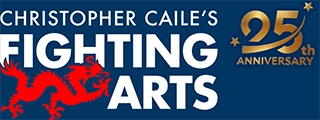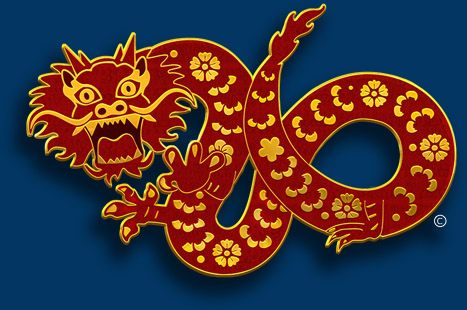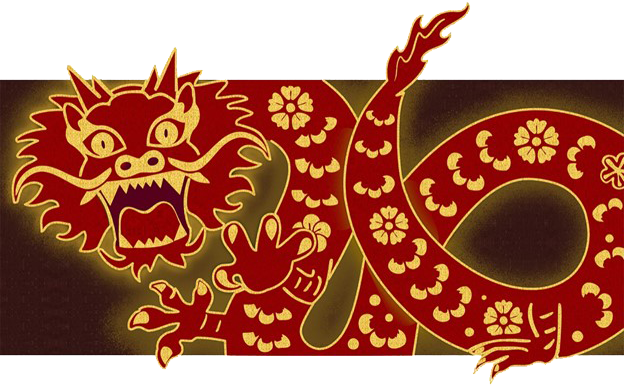A Spirit That Inspires – The Story Of Kevin, Continued
By Christopher Caile
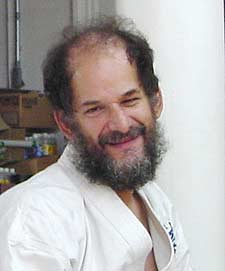
Kevin Fabiny
Last weekend I was thrilled to see and house in NYC a former student of mine from Buffalo, NY who was asked to test for his second-degree black belt in karate.
His name is Kevin Fabiny. He is very different from other karate students, because since birth he has been severely limited physically.
Born with cerebral palsy, he was for most of his life pretty much limited to a wheel chair. For this reason he was never allowed to participate in sports.
This all changed almost 21 years ago when I was teaching Seido Karate at the State University of New York at Buffalo (SUNY). One evening before class as people were warming up, a bearded man in a wheel chair (he was a student there at this time) came to the edge of the mat and said something. I had no idea what he said.
Again he spoke in very blurred speech, "Caan Iiii Stuuudy Karrratttee?"
This time I understood him, and after thinking for a moment I said "yes," but that I wouldn't make special accommodations for him. If he fell down, he would have to get up himself.
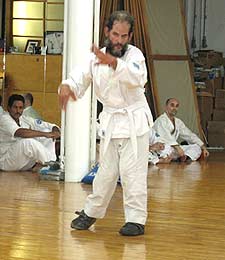 |
Kevin performing kata during his test |
Kevin looked back somewhat surprised. Although his speech was difficult to understand, he said that he had asked various sports organizations and clubs for years if he could participate, but the answer had always been "NO."
I was teaching Seido Karate (a club program) which was founded by Kaicho Tadashi Nakamura who had left a senior position as a member of a very hard, full contact style of karate (Kyokushin). His great insight on founding Seido was that karate and its philosophy could benefit everyone, not just the young, strong and those who wanted to specialize in hard fighting.
Kevin is an example of this challenge. Over the years I watched Kevin get stronger, and his growing ability to escape the wheelchair, to walk better without assistance, to climb stairs and to fend for himself. His movements improved, although he was always limited by poor coordination, muscle control, balance and strength.
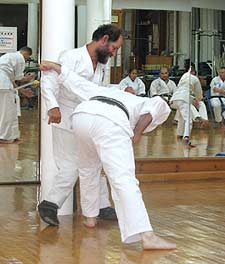 |
Kevin with a partner demonstrates a self-defense technique. |
But stubbornly Kevin came to class. When I was teaching Kevin had to use his motorized wheelchair to get to the subway and take it to one campus, then take a campus special handicapped vehicle between campuses, then get himself to the training facility and then at the end of class do the reverse to get home. There were even times when he came to class without his wheel chair, but this required extra effort to walk to the subway and ride a regular bus between campuses. I understand that he continues this two hour each way ritual even today.
He would always arrive an hour or two before class so he could do his own kind of physical therapy—climbing stairs, walking around the running track, doing modified push-ups, etc. and then participate in class. He eventually achieved his black belt. (See "The Story About Kevin").
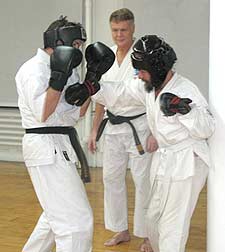 |
Kevin participating in free fighting, with the author, Sei Shihan Christopher Caile supervising (background). Over the course of an hour Kevin fought four or five opponents. While he is able to punch and block, Kevin has very limited kicking ability due to his physical limitations. |
Over time I began to realize the Kevin was also fighting for his life. He once told me that people with his condition often deteriorated physically which could lead to premature death. Thus his work ethic, his karate participation, was staving off physical deterioration.
In Seido we have a saying, "Technique rather than strength and spirit rather than technique." And while Kevin was limited in the first two, he remains inspirational in his spirit. In this way he taught me a lot.
After I left Buffalo more than ten years ago, Kevin continued under Sensei Jeff Evenson and then Senpai Peter Macaluso when he took over the program. Kevin is now the senior student. He has been like the "Energizer Bunny." He keeps coming to class, and keeps practicing. This year he was asked to test for his second-degree black belt.
When I saw Kevin again I realized that this test would even be harder for him. Despite all his efforts, exercise and practice, he has lost some muscle strength and his balance has deteriorated a bit. Kevin told me that previously when he fell down, he could usually get up in place, but now he had to crawl to a wall or pillar and use that to help himself get upright.
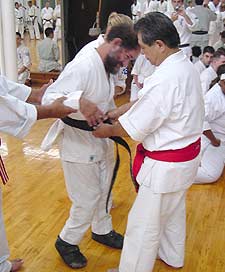 |
Kevin being awarded his second-degree black belt by Kaicho Tadashi Nakamura. |
His eyesight has also become more limited too. Never great, over the last few years he has totally lost sight in one eye.
I think he is probably afraid for his future, although he doesn't show it. One of the students who accompanied him from Buffalo said that Kevin told him where he wanted to be buried and how. But this last week I never saw any cloud over his thoughts. When I asked him about his comments to the other student, he told me of his father who was now 86 years old and that he has good genes.
And in all the time I have known him, Kevin has never been bitter, or shown a negative attitude or anger toward his condition. Instead, he has always been upbeat, and quick with the joke or insightful comment.
During his two-day test Kevin fully participated – he didn't want special treatment. He free fought, demonstrated kata and self-defense drills and two-man exercises with others taking their tests.
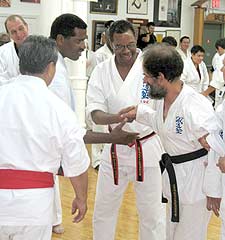 |
Kaicho Nakamura and Sei Shihans William Best and Mike Reeves congratulating Kevin after his promotion. |
At this point you might be asking yourself, "How could a man so physically limited ever qualify for a black belt, much less a second degree black belt?" The answer is simple.
Belts in martial arts don't just signify strength or fighting ability (that's why in most pure sports there are no ranks or belts). They also signify personal development, discipline and spirit. That's also why there are junior belts. Those under 16 (sometimes 15) aren't considered to have developed mentally to the point that they can exhibit a developed sense of morality, internal direction, dedication to practice and outward exhibition of etiquette necessity for award of a full black belt. Thus junior belts are considered incomplete, usually with a white or other color stripe down the middle.
Kevin in his test over two days showed everyone something rare – limited ability totally over shadowed by spirit, of stick-to-it-ness, self-discipline and strength of commitment. It was inspirational.
At the conclusion of testing, participants were awarded their belts. Kaicho Nakamura asked me to introduce Kevin and give some background on him and his studies. I recounted his history, his challenges, his work ethic as well as his keen sense of humor, his insightful knowledge. I also noted that the one time he had been attacked, he had nearly beaten up his assailant before other intervened.
I told the other students that whenever I feel tired, or had a small injury, and thought about missing practice, I think of Kevin who has to try so much to do anything. I remember Kevin falling down, again and again and again and getting himself up – literally thousand of times. His continued practice illustrates the principle "strength of spirit over flesh, of discipline over weakness, and of mind over body."
There was thunderous applause, and more than a few tears were seen on the faces of others.
I want to thank Kevin for showing me his way, his spirit and dedication and as such he has become one of my teachers. And if in Buffalo on the street or at the University of Buffalo you see a partially bald and bush bearded man in a wheel chair, pay him some respect. If it is Kevin, he has earned it.
About the Author Christopher Caile
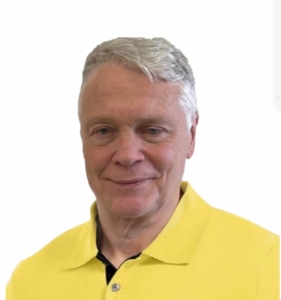
Screenshot
Christopher Caile is the Founder and Editor-In-Chief of FightingArts.com. He has been a student of the martial arts for over 65 years.
He first started in judo while in college. Then he added karate as a student of Phil Koeppel in 1959 studying Kempo and Wado-Ryu karate. He later added Shotokan Karate where he was promoted to brown belt and taught beginner classes. In 1960 while living in Finland, Caile introduced karate to that country and placed fourth in that nation's first national judo tournament.
Wanting to further his karate studies, Caile then hitch hiked from Finland to Japan traveling through Scandinavia, Europe, North Africa, the Middle East and South and Southeast Asia — living on 25 cents a day and often sleeping outside.
Arriving in Japan (1962), Caile was introduced to Mas Oyama and his fledgling full contact Kyokushinkai Karate by Donn Draeger, the famous martial artist and historian. Donn also housed him with several other senior international judo practitioners. Donn became Caile's martial arts mentor, coaching him in judo and introducing him to Shinto Muso-ryu under Takaji Shimizu.
Caile studied at Oyama's honbu dojo and also at Kenji Kurosaki's second Tokyo Kyokushinkai dojo. In his first day in class Oyama asked Caile to teach English to his chief instructor, Tadashi Nakamura. They have been friends ever since. Caile also participated in Oyama's masterwork book, "This Is Karate."
Caile left Japan with his black belt and designation as Branch Chief, the first in the US to have had extensive training in Japan directly under Oyama Sensei. As such, Oyama Sensei asked him to be his representative on visits to his US dojos to report on their status.
A little over a year later, Nakamura, Kusosaki and Akio Fujihira won an epic David vs. Goliath challenge match against Thailand's professional Muay Thai Boxers in Bangkok, Thailand, thrusting Kyolushinkai and Nakamura into national prominence.
Back in the US Caile taught Kyokushinkai karate in Peoria, Il while in college and later in Washington, DC. while in graduate school. Durimg this time Shihan Nakamura had moved to New York City to head Kyokushinkai's North American Operation.
In 1976 when Kaicho Tadashi Nakamura formed the World Seido Karate organization, Caile followed. Living then in Buffalo, NY, Caile taught Seido karate and self-defense at the State University of New York at Buffalo (SUNY Buffalo) for over 15 years where he also frequently lectured on martial arts and Zen in courses on Japanese culture.
Caile moved to New York City in 1999 to marry Jackie Veit. He is now an 8th degree black belt, Hanshi, training in Seido Karate's Westchester, NY Johshin Honzan (Spiritual Center) dojo. In Seido Caile is known for his teaching of and seminars on kata applications. He also produced a 14 segment video series on Pinan kata Bunkai currently available to Seido members.
Caile is also a long-time student and Shihan in Aikido. He studied in Buffalo, under Mike Hawley Shihan, and then under Wadokai Aikido's founder, the late Roy Suenaka (uchi deshi under Morihei Ueshiba, founder of Aikido and was Shihan under Tohei Sensei). In karate, Suenaka (8thdan) was also an in-house student of the Okinawan karate master Hohan Soken.
Having moved to New York City, Caile in 2000 founded this martial arts educational website, FightingArts.com. Twenty-five years later, in 2025, it underwent a major update and revision.
For FightingArts.com and other publications Caile wrote hundreds of articles on karate, martial arts, Japanese art, Chinese Medicine and edited a book on Zen. He also developed relationships with a cross section of leading martial arts teachers. Over the last four decades he has conducted extensive private research into karate and martial arts including private translations of the once secret Okinawan hand copied and passed on Kung Fu book, the Bubishi, as well as an early karate book by the karate master Kenwa Mabuni. He periodically returns to Japan and Okinawa to continue his studies and participate Seido karate events. In Tokyo he practiced (with Roy Suenaka Sensei) in a variety of aikido organizations with their founders – including private interviews and practices at the Aiki-kai Aikido Honbu dojo with the son and grandson of aikido's founder, Doshu (headmaster) Kisshomaru (an old uchi-deshi friend) and his son, Moriteru Ueshiba and in Iwama with Morihiro Saito. On Okinawa he studied Goju Ryu karate under Eiichi Miyazato, 10th dan founder of Naha's Jundokan, and also with Yoshitaka Taira (who later formed his own organization, who specialized in kata Bunkai. While there Caile also trained with Hohan Soken's senior student, Master Fusei Kise, 10 dan as well as with the grandson of the legendary karate master Anko Itosu.
Caile's other martial arts experience includes: Diato-ryu Aikijujitsu and Kenjitsu, kobudo, boxing, Muay Thai, MMA, Kali (empty hand, knife and bolo), study of old Okinawan Shoran-ryu & Tomari body mechanics, study of old Okinawan kata under Richard Kim, study of close quarter defense and combat, including knife and gun defenses, Kyusho Jitsu and several Chinese fighting arts including 8 Star Praying Mantis, Pak Mei (White Eyebrow), and a private family system of Kung Fu.
Caile is also a student of Zen as well as a long-term student of one branch of Traditional Chinese Medicine, Chi Kung (Qigong). As one of two senior disciples of Chi Kung master Dr. Shen (M.D., Ph.D.) Caile was certified to teach and practice. This led to Caile's founding of the The Chi Kung Healing Institute on Grand Island, NY. In Western NY, he also frequently held Chi Kung seminars, including at SUNY Buffalo and at the famous Chautauqua Institution in Chautauqua, NY. His articles on Chi Kung also appeared in the Holistic Health Journal and in several books on alternative medicine.
Caile holds a BA in International Studies from Bradley University and MA in International Relations with a specialty in South and Southeast Asia from American University in Washington, D.C. While in Buffalo, NY he also studied digital and analog electronics.
In his professional life Caile also worked in public relations and as a newspaper reporter and photographer. Earlier he worked in the field of telecommunications including Managing a Buffalo, NY sales and service branch for ITT. He then founded his own private telephone company. This was followed by creation of an electrical engineering company that designed and patented his concept for a new type of low-cost small business telephone system (which was eventually sold to Bell South). The company also did contract work for Kodak and the US space program. Simultaneously Caile designed and manufactured a unique break-apart portable pontoon boat.
Most recently Caile co-founded an internet software company. Its products include software suites with AI capability for control and management of streaming media, such as video and music, an all-in-one book publishing software product for hardcover, eBook and audio book creation and security software for buildings and government use.
For more details about Christopher Caile's martial arts, work experience and life profile, see the About section in the footer of this site.
Search for more articles by this author:
